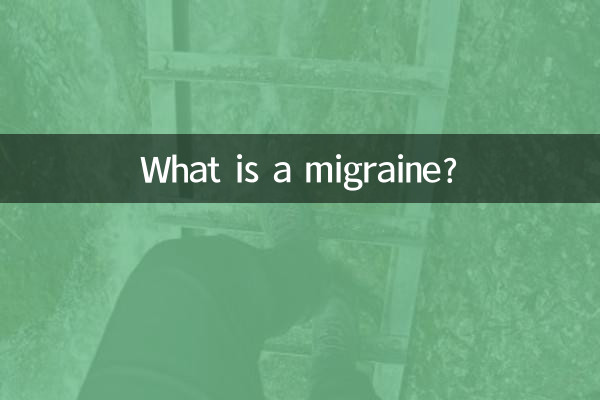What is a migraine?
Migraine is a common neurological disorder characterized by recurring headaches, often accompanied by symptoms such as nausea, vomiting, light sensitivity, or sound sensitivity. In recent years, with the accelerated pace of life and increased work pressure, the incidence of migraines has been on the rise. This article will combine the hot topics and hot content on the Internet in the past 10 days to provide you with a detailed analysis of migraine-related situations.
1. Symptoms and classification of migraine

Migraine symptoms vary from person to person, but common symptoms include:
| Symptom type | Specific performance |
|---|---|
| headache | Mostly unilateral throbbing pain, lasting 4-72 hours |
| accompanying symptoms | Nausea, vomiting, light sensitivity, sound sensitivity |
| Aura symptoms | Visual abnormalities (such as flashes of light, dark spots), sensory abnormalities (such as numbness) |
According to the classification of the International Headache Society, migraines are mainly divided into the following two categories:
| Classification | Features |
|---|---|
| Migraine without aura | There are no aura symptoms before the headache, accounting for 70%-90% of migraine patients. |
| Migraine with aura | There are clear aura symptoms before the headache, accounting for 10%-30% of migraine patients. |
2. Migraine triggering factors
Migraine attacks are often related to a variety of factors. The following are the migraine triggers that have been hotly discussed on the Internet in the past 10 days:
| Predisposing factors | Specific instructions |
|---|---|
| pressure | Work pressure and mood swings are common triggers |
| diet | Alcohol, caffeine, chocolate, etc. may induce |
| sleep | Not enough or too much sleep can cause |
| environment | Strong light, noise, weather changes, etc. |
| hormones | Hormonal changes related to women’s menstrual cycle |
3. Migraine treatment methods
Treatment for migraine mainly includes acute treatment and preventive treatment. The following are the current mainstream treatments:
| treatment type | Specific methods |
|---|---|
| acute phase treatment | Nonsteroidal anti-inflammatory drugs, triptans, antiemetics, etc. |
| preventive treatment | Beta blockers, antidepressants, antiepileptic drugs, etc. |
| non-drug therapy | Acupuncture, biofeedback, cognitive behavioral therapy, etc. |
4. Preventive measures for migraine
The key to preventing migraine attacks is to identify and avoid triggers and establish a healthy lifestyle:
| Precautions | specific suggestions |
|---|---|
| Regular schedule | Maintain a regular sleep schedule and avoid staying up late |
| Diet management | Avoid known trigger foods and stay well hydrated |
| stress management | Learn relaxation techniques such as meditation and deep breathing |
| moderate exercise | Engage in regular aerobic exercise but avoid strenuous exercise |
| environmental control | Avoid stimulation such as strong light, noise, etc. |
5. Latest research progress on migraine
According to recent research hot spots, the following new discoveries have been made in the field of migraine:
| Research direction | Latest findings |
|---|---|
| genetic research | Multiple genetic loci linked to migraine discovered |
| neural mechanism | The activation mechanism of the trigeminal neurovascular system is more clear |
| New drug research and development | CGRP-targeting drug shows promising results |
| digital therapy | APP-based cognitive behavioral therapy makes progress |
6. Daily management suggestions for migraine patients
For people with migraines, the following management strategies are recommended:
1.Keep a headache diary: Record in detail the time, symptoms, triggers and treatment effects of each attack to help doctors develop personalized treatment plans.
2.Establish an early warning system: Learn to recognize aura symptoms or early signs and take timely measures before a headache attacks.
3.Seek professional help: When the frequency of headaches increases or symptoms worsen, you should seek medical treatment promptly and avoid abusing painkillers on your own.
4.Join a support group: Share experiences with other patients and get emotional support and practical advice.
5.stay positive: Although migraine attacks may come and go, with scientific management, most patients can maintain a good quality of life.
Migraine is a complex condition that requires comprehensive treatment and long-term management. By understanding its symptoms, triggers, and treatment options, patients can better manage their condition and reduce the frequency and severity of attacks. If you or someone around you often suffers from migraines, it is recommended to consult a professional doctor in time to develop a suitable treatment plan.

check the details

check the details